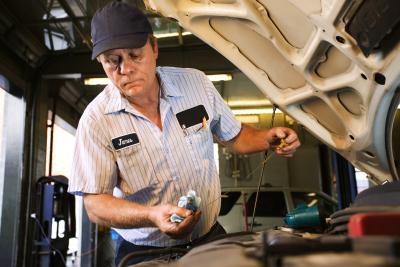
The Kia Sportage made its debut in the U.S. marketplace in 1995. Unable to effectively compete with established competitors, Kia dropped the model in 2002. In 2005, however, Kia reintroduced a new compact sport utility vehicle (SUV) using the Sportage name. The 2001 Sportage featured a twin-cam, 2.0-liter, four-cylinder engine rated at 139 horsepower. Proper cooling is critical to the operation of any engine, and the thermostat is an inexpensive but vital component of the engine cooling system. Replacing a malfunctioning thermostat is a relatively easy task Sportage owners can do themselves.
Park the vehicle on a level surface. Allow the engine to cool.
Take off the radiator cap. Place the catch pan under the drain cock on the bottom of the radiator. Open the drain cock until coolant flows freely out of the radiator. Drain the radiator until the coolant level in the radiator is below the level of the thermostat housing. Close the radiator drain cock.
Trace the upper radiator hose back to the engine to locate the thermostat housing. Place the drip pan on the ground under the housing to catch any accidental coolant spills. Unscrew the two retaining nuts on the thermostat cover. Remove the cover from the thermostat housing. Remove the gasket. If the gasket is stuck, carefully scrape the gasket off the metal. Do not let parts of the gasket fall into the thermostat housing.
Examine the existing thermostat and note the direction it is facing. Remove the used thermostat. Install the new thermostat, making sure it is facing in the proper direction and that it is properly seated in the housing.
Install a new gasket. Align the gasket with the openings for the thermostat and the two retaining studs for the thermostat housing cover. Replace the thermostat housing cover, and secure it with the retaining nuts. Do not overtighten the housing retaining nuts, because that could cause damage to the gasket.
Refill the radiator with a mixture of half automotive antifreeze and half water. This provides optimum engine cooling while preventing boiling of the coolant fluid.
Test the new thermostat operation by starting the engine and allowing it to warm up with the radiator cap removed. As the engine approaches normal operating temperature, the thermostat should open and coolant flow should be visible in the radiator. Replace the radiator cap as soon as the coolant flow is visible. Allow the engine to warm to normal operating temperature. Check the thermostat housing for fluid leaks. Make sure the engine cooling fan located behind the radiator turns on and off as it should. Be sure the temperature gauge on the driver's instrument panel indicates a normal engine temperature.